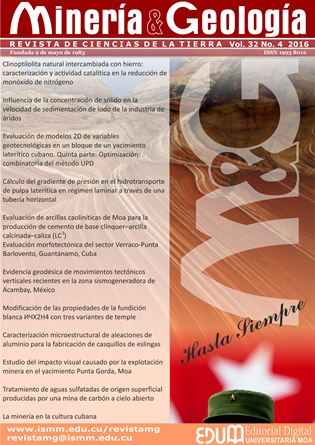Changes in the properties of white cast iron ичx2h4 under conditions of variations of heating
Keywords:
air quenching, white cast iron, abrasion, hardness, impact loads.Abstract
The influence of three heating variants, during hardening on the properties of national manufactured ИЧX2H4 white cast iron were evaluated at laboratory scale in order to predict the feasibility of using it on the manufacturing of mining equipments for abrasion and impact conditions. Cast samples, with controlled chemical composition and further annealed, were used for evaluating three heating variants with air quenching. The chemical composition of cast samples was in correspondence with the composition established by the standard GOST 5632-72. After air quenched, samples were annealed and characterized using optical microscope and hardness testing. It is concluded that in the three evaluated of heating variants, the required properties for manufacturing parts from equipments that undergo severe abrasion and impact loads were obtained; such as crashing and grinding mining equipments.Downloads
References
ASTM A532: 2004: Standard specification for abrasion-resistant cast irons, ASTM International. West Conshohocken, PA, United States.
ASTM E-92: 2003: Standard Test Method for Vickers Hardness of Metallic Materials. ASTM International.
ASTM G65-94: 2000: Standard Test Method for Measuring Abrasion Using the Dry Sand/Rubber Wheel Apparatus, ASTM International.
BLAZEVIC, D. 2002: Hot strip mill operation. Vol. III. Sun Lakes, Arizona, EE. UU.
COLLINI, L.; NICOLETTO, G. & CONENÁK, R. 2008: Microstructure and mechanical properties of pearlitic gray cast iron. Materials Science and Engineering A 488(112): 529-539.
CLAASGUSS GmbH. 2012: Abrasion resistant, white cast iron materials. Technical Information No. 11.
GULIAEV, A. P. 1983: Metalografía. T. I y II. Editorial Mir, Moscú.
FERNÁNDEZ-COLUMBIÉ, T.; RODRÍGUEZ, I.; CORREA, R. & ALCÁNTARA, D. 2014: Junta de soldadura disímil de la aleación HK–40 y del hierro fundido 24. Ingeniería Mecánica 17(2): 98-107.
FERNÁNDEZ, I. & BELZUNCe, F. 2006: Influencia de diversos tratamientos térmicos en la microestructura de una fundición blanca con alto contenido en cromo. Revista de Metalurgia 42(4): 279-286.
FIGUEREDO, Y.; PALACIOS, A.; VELÁZQUEZ, A. & GARCÍA, E. 2013: El recocido de esferoidización como vía para mejorar la maquinabilidad de la aleación ИЧX28H2. Minería y Geología 29(1): 60-76.
HINCKLEY, B.; DOLMAN, K. F.; WUHRER, R.; YEUNG, W. & RAY, A. 2008: SEM investigation of heat treated high-chromium cast irons. Materials Forum 32: 55-71.
HUGGETT, P. & BEN, B. 2007: Development of a low melting point white cast iron for use in composite alloy manufacture. Materials Forum 31: 16-23.
ISO 21988: 2006: International Organization for Standardization, Abrasion-resistant cast irons–classification, Geneva, Switzerland: ISO Copyright Office.
Walton, C. F. & Opar, T. J. 1981: Iron castings handbook. Iron casting society 235: 297-321.
WANG, J.; LI, C.; LIU, H.; YANG, H.; SHEN, B.; GAO, S. & HUANG, S. 2006: The precipitation and transformation of secondary carbides in a high chromium cast iron. Materials Characterization 56(13): 73–78.
ZHANG, M.; KELLY, P. & GATES, J. 2001: The Effect of Heat Treatment on the Toughness, Hardness and Microstructure of Low Carbon White Cast Irons. Journal of Materials Science 36(15): 3865–3875.
ZHAO, H. & LIU, B. 2001: Modeling of stable and metastable eutectic transformation of spheroidal graphite iron casting. ISIJ international 41(9): 986-991.
Published
How to Cite
Issue
Section
Copyright (c) 2016 Tomás Fernández-Columbié, Gleydis Dueñas- Rodríguez, Armín Mariño-Pérez, Alberto Velázquez-del Rosario, Dayanis Alcántara-Borges

This work is licensed under a Creative Commons Attribution-NonCommercial 4.0 International License.
- Authors retain copyright and guaranteeing the right magazine to be the first publication of the work as licensed under a Creative Commons Attribution-NonCommercial that allows others to share the work with an acknowledgment of the work's authorship and initial publication in this journal.
- Authors may establish separate supplemental agreements for the exclusive distribution version of the work published in the journal (eg, place it in an institutional repository or publish it in a book), with an acknowledgment of its initial publication in this journal.
- Authors are allowed and recommended to disseminate their work through the Internet (e.g., in institutional telematic archives or on their websites) before and during the submission process, which can produce interesting exchanges and increase citations of the published work. (See The effect of open access)










